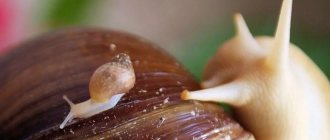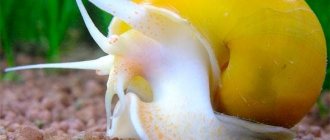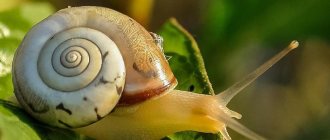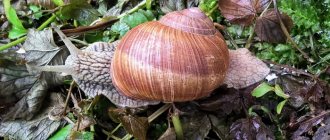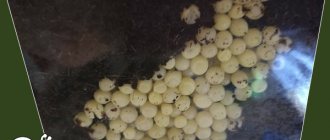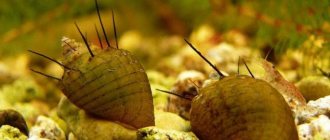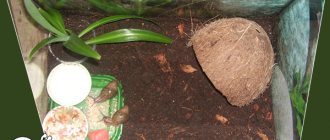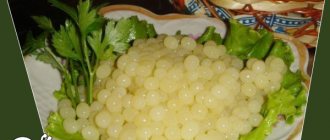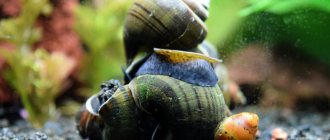The snail's shell is its main attraction, its home and reliable protection. The life of the mollusk literally depends on its condition. The shell is the external skeleton of the snail; it is securely attached to the body by special muscles and not only protects it from damage, but also supports the internal organs in the correct position. Without a “house,” gastropods face certain death. In natural conditions, it will most likely become an easy prey, and in domestic conditions it will not live long either, even with very good care. There are two main factors at play here:
- dehydration - since moisture is lost very quickly without a shell;
- inability to move normally - organs are displaced, there is no center of gravity, it is difficult for the snail to control its body.
Domestic snails, especially such large and “heavy” ones as Achatina, must be protected from falling and blows so as not to damage their fragile “house”.
Snails are found everywhere
Worldwide, the gastropod family contains approximately 70,000 different species. These include all land, sea and freshwater snails and slugs. Of these 70,000 species, about 5,000 live in seas, oceans, brackish and fresh waters; other species live on land.
Photo: Aquatic Arts
Depending on its habitat, the snail can be bright (yellow, orange, red) or inconspicuous (white, gray, brown).
Gastropods live everywhere, from the tropics to the Arctic and Antarctic. Many species of snails can live in the same habitat without competing with each other. This is possible because different species have different food preferences.
Enemies in the wild
Gastropods are among the most invisible organisms on earth. But despite this, the individual has enough enemies:
- sea gobies;
- sardine;
- sea stars;
- mackerel;
- whales;
- herring;
- hermit crabs.
For land snails, the following are dangerous:
- moles;
- blackbirds;
- wild boars;
- lizards;
- hedgehogs
Freshwater mollusks should be afraid of:
- trout;
- storks;
- frogs;
- herons.
Snails are slow and careful, which helps them protect themselves from enemies. They avoid highly lit areas and stay deep in the substrate.
Most snails are herbivores
Freshwater snails feed mainly on algae growing on the surface of the substrate. Terrestrial individuals prefer leaves, lichens, fungi and rotting plant debris. Some species are omnivores and their diet consists of a variety of invertebrates and plants.
Snails and other gastropods feed using a radula. This mouthpart collects food from the surface of the substrate, acting like a conveyor belt to deliver nutritious morsels to the back of the mouth. The radula can have up to 14,000 miniature jagged projections! If the snail breaks off too large a piece of food, it can break it into smaller pieces by rubbing them against the hard plate on the roof of the mouth.
Different species of snails have radulas that are specially adapted for collecting and breaking down the main food products of that species.
Photo: Krzysztof Niewolny
How often and in what quantity to feed
In order for the life of a mollusk in an aquarium to be comfortable, it is necessary to adhere to certain rules. One important aspect is the volume of the tank in which they live. To increase the likelihood of growing a large snail, about 12–15 liters per individual is required.
Achatina eat lettuce leaves
Another important rule is nutrition. We will talk about how to feed snails at home.
Food must be given in the evening, since domestic snails are nocturnal animals. It is recommended to feed shellfish once a day. The amount of food depends on the number of individuals. There is no need to worry about overeating snails, as they always know their limits. The tastes of each individual are different. You can notice this by observing the process of the meal. Almost every snail eats one type of food.
The main diet is plant foods, as well as some types of fruits and vegetables. To maintain vitamin balance, it is recommended to add calcium supplement to the water.
You need to be careful when feeding baby snails. Their diet is noticeably different from the diet of adult mollusks. Kids eat mostly greens and grated carrots. Over time, you can switch to apple pieces.
The habitat of snails depends on their species
Freshwater snails require specific environmental conditions to survive. The most important are the pH level of the water (also known as acidity) and the concentration of calcium carbonate in the water. Calcium carbonate is necessary for snails to form shells. Moreover, 45% of freshwater snails can be found in water with a calcium concentration of 20 mg/l or more. The remaining 55% of snails require a concentration of at least 3 mg/l. Where there is not enough calcium carbonate in the water to create shells, slugs appear.
The range of aquatic snails is wide, as they are often carried away by strong currents. Regions where water tends to dry out or freeze during the summer and winter months support only a few species of snails.
Land snails and other gastropods have adapted to all environments except air (we are not aware of flying snails). At night they come out to feed, and during the day they rest in protected places, for example, under stones. If conditions are too dry, the snail retreats into its shell, which it is able to seal: it can remain in this state for several months if necessary. During the winter, land snails usually hibernate. They are covered with a thick layer of mucus, which prevents water loss from the body. The dormant period ends when weather conditions improve.
Land and sea snails lay eggs, freshwater snails lay viviparous mollusks
Most terrestrial species have both female and male reproductive cells (they are hemaphroditic). They don't actually need to mate with another snail to reproduce because self-fertilization is possible. Parthenogenesis is especially important in areas where there are few partners. After mating, the females lay about 80 white eggs in a moist underground nest. Newly hatched snails have fragile shells and take about two years to mature.
Photo: Shutterstock
Some terrestrial gastropods “shoot” so-called “love arrows” at their potential partner. But this is rather an element of the mating dance that precedes the process of reproduction.
Most aquatic snails have male and female species. Freshwater females give birth to live young. Young animals look like smaller copies of adults. They develop quickly and mate at a young age to compensate for the lack of a larval stage.
But snails that live in the marine environment, like their terrestrial counterparts, lay fertilized eggs. They can lay eggs every month.
Social structure and reproduction
Photo: Grape snail in Belarus
Puberty in grape snails occurs at the age of 1-1.5 years. Snails have several reproductive peaks, the first in the spring immediately after waking up from hibernation - the end of March-June. The second breeding season occurs in early autumn. During the courtship ritual, the snail crawls rather slowly in a circle, sometimes raising the front part of its body. Stops as if looking for someone.
When a pair of such snails meet, they begin to stretch out one on top of the other, feel each other with their tentacles, and touch their soles. After some time, the snails fall to the surface, pressing their soles together in this state, they remain motionless for about 15 minutes. Later, the mating game resumes until one of the snails inserts a sexual organ into the other. During copulation, both snails act as both male and female. After copulation, the snails scatter in different directions.
Interesting fact: During mating, the snail receives sperm phones, which it can store for a whole year, until it finds favorable conditions for laying eggs.
To lay eggs, the snail forms a clutch by digging a hole 5-10 cm deep, and later compacting the soil to form the walls of the shelter. Sometimes clutches are created in natural shelters, for example, near plant rhizomes. At one time, the clutch contains 40 pearl-colored eggs. Laying eggs is a rather complex process for snails, and about a third of the snails die after leaving their offspring. The incubation period lasts about a month. The snails that hatch from the egg are a small version of the adult. They have an absolutely smooth and transparent shell with only 1.5 curls. On the 10th day, young snails leave their nest and go outside in search of food.
Snails are almost completely blind
In aquatic snails, the eyes are located directly on the head, and in terrestrial species, they are located on the top of long tentacles. The short tentacles are equipped with sensors of touch and smell. The snail uses them to search for food, since the eyes are almost completely blind.
Photo: ERROR 420
A keen sense of smell helps snails find food from just a few meters away, which is quite a long distance for an animal of such a tiny size.
The snail's body consists of three main parts: head, mantle and legs.
The leg is a fleshy muscle that extends from the bottom of the shell. By contracting the muscle, the cochlea moves along the surface in wave-like movements. Small species of snails move using the beating of eukaryotic cilia.
The mantle is the part of the snail that secretes the shell, a spiral shell. The mollusk uses the shell as a shelter in case of detection of danger. A snail's shell grows throughout its life. Chemically, it consists of calcium carbonate. Therefore, gastropods require a calcium-rich diet to provide a strong shell.
Some snail species have a second "door" on the shell, called the operculum, in addition to the main exit, from which the leg muscle protrudes.
Snails are some of the slowest creatures on the planet
Snails produce mucus, which makes it easier for them to glide across surfaces by reducing friction. Thanks to this substance, they can easily move even upside down on vertical surfaces.
Photo: Luke Brugger
To move faster, snails often use the mucus trails of other snails. But even these fast slimy trails do not allow them to reach speeds higher than 1.3 cm per second. Aquatic snails usually move even slower. However, when in danger, they can move very quickly, “running” across the surface of the water!
There is a widespread myth that snail mucus makes food inedible, but scientists have proven that it is beneficial. Several studies have shown that snail mucus can be used to treat stomach ulcers.
Treatment
The giant Achatina snail without a shell, like any land mollusk, cannot live long, despite its impressive size. If such a situation occurs, it will be very difficult to correct it. But you shouldn’t give up right away. If there is at least one chance of salvation, you must definitely take advantage of it.
If it is discovered that the snail has completely or partially “lost its home”, it needs to be:
- Place very carefully in a separate container. There she will not suffer even more from the actions of her relatives.
- Then you should wash your hands thoroughly and try to return the mollusk to its shell with careful movements.
- If the pet “returns home” by at least two millimeters, that will be quite good. Then the snail can independently pull itself into the shell.
To disinfect a shellfish, it is placed in a mitronidazole solution (half a tablet per 125 ml of water, which is pre-boiled and cooled to a warm state). In this case, you need to ensure that the gastropod does not drown during the bathing process. After this, it is planted in a low container, at the bottom of which there is a damp towel. Such an ulitaria must have the necessary temperature and humidity for the mollusk, without which its body will quickly dry out.
Snails can be poisonous
Some marine snail species are poisonous, but most land species are not. Cone snails are a family of nearly 600 species of marine gastropods. These are some of the deadliest creatures in the world, and one bite can kill a person. An antidote for their bite has not yet been found.
Photo: David Paul
It is a sought after food source for many predators
Snails are an important food source for wildlife and people (they are eaten throughout the world as a delicacy). Aquatic individuals are preyed upon by predatory fish, crayfish, leeches and giant water bugs. For terrestrial individuals, mammals, birds and some types of insects pose a danger.
Snails are also kept as pets, but they are usually classified as pests (due to their ability to destroy garden plants and crops).
Did you know?
- The name gastropods comes from the Latin words "Gasto", meaning stomach, and "poda", meaning foot.
- The snail can reach from 0.1 to 40 cm in length and weigh from 60 to 900 grams. Achatina giant is the largest snail on the planet.
- The garden snail is the most common species of gastropod in Europe. It has pale gray moist skin and a large brown or yellowish shell with light spots and darker spiral stripes.
- During development, the snail's body rotates 180 degrees counterclockwise inside the shell. This causes her anus to be directly above her head!
- Land snails breathe through their lungs. Individuals living in freshwater and marine waters use gills for breathing.
- Snails live from 3 to 7 years in the wild and up to 25 years in captivity. Life expectancy depends on what species they belong to and in what habitat they live.
- In Ancient Egypt, the snail symbolized fertility and eternity, in the Middle Ages - sin and laziness, in Buddhism - patience, and in Islam - doubt.
Origin of the species and description
Photo: Grape snail
Helix pomatia or Grape snail is a terrestrial mollusk belonging to the class of gastropods, order of stalked animals, family of Holicides. Genus Helix species Helix pomatia grape snail. This snail is also popularly called Apple snail or Apple snail, Moon snail or Burgundy snail. Snails are one of the most ancient creatures on our planet.
Back in the Cretaceous period of the Mesozoic era, snails already inhabited our land. The oldest remains of representatives of gastropods are 99 million years old. The remains were found in Burma during amber excavations. The ancient mollusk even preserved its soft tissues, due to the fact that the snail got into amber and could not get out of it.
Video: Grape snail
The species Helix pomatia was first described by the Swedish naturalist Carl Linnaeus in 1758. The grape snail is considered the largest snail in Europe; the adult shell size is up to 46 mm, the shell width is up to 47 mm. An adult may weigh up to 45 grams. The grape snail is a large gastropod mollusk from the order Stem-Eyed.
The body of the mollusk is asymmetrical. The head is clearly defined. The head has two pairs of tentacles and eyes. The shell is curved in the form of a spiral and has 4.5 turns. The color of the grape snail is uniform yellowish-orange. This mollusk breathes air using its lungs. Pneumostome - a small breathing hole located between the folds of the mantle and opens every minute.

